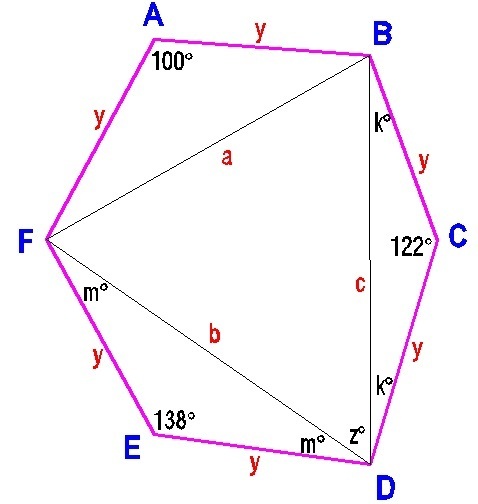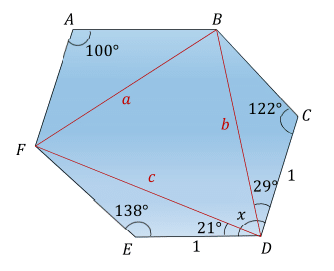Hexed Hex
An equilateral hexagon, that is one with all sides equal to one another, has ∠ B C D = 1 2 2 ∘ , ∠ D E F = 1 3 8 ∘ , ∠ F A B = 1 0 0 ∘ . Find ∠ C D E in degrees.
Inspiration
: Calvin Lin's Problems of the Week, March 20
The answer is 100.
This section requires Javascript.
You are seeing this because something didn't load right. We suggest you, (a) try
refreshing the page, (b) enabling javascript if it is disabled on your browser and,
finally, (c)
loading the
non-javascript version of this page
. We're sorry about the hassle.
3 solutions
 By Law of Cosines
By Law of Cosines
a 2 = 2 y 2 − 2 y 2 c o s 1 0 0 = y 2 ( 2 − 2 c o s 1 0 0 )
a = y 2 − 2 c o s 1 0 0
b 2 = y 2 ( 2 − 2 c o s 1 3 8
b = y 2 − 2 c o s 1 3 8
c 2 = y 2 ( 2 − 2 c o s 1 2 2 )
c = y 2 − 2 c o s 1 2 2
Solving for m ,
y 2 = y 2 + b 2 − 2 ( y ) ( b ) c o s m
m = 2 1
Solving for k ,
y 2 = y 2 + c 2 − 2 ( y ) ( c ) c o s k
k = 2 9
Solving for z ,
a 2 = b 2 + c 2 − 2 ( b ) ( c ) c o s z
z = 5 0
∠ C D E = 2 1 + 2 9 + 5 0 = 1 0 0
 Angle
x
=
∠
E
D
F
+
∠
F
D
B
+
∠
B
D
C
.
Angle
x
=
∠
E
D
F
+
∠
F
D
B
+
∠
B
D
C
.
Angle E D F = 2 1 ( 1 8 0 ∘ − 1 3 8 ∘ ) = 2 1 ∘ from the isosceles triangle E D F .
Angle B D C = 2 1 ( 1 8 0 ∘ − 1 2 2 ∘ ) = 2 9 ∘ from the isosceles triangle B D C .
To get angle F D B we will use the triangle F D B , after we find its sides a , b and c using the law of cosines and the arbitrary assumption that every side of the hexagon is size 1.
a = 2 − 2 c o s ( 1 0 0 ) = 1 . 5 3 2
b = 2 − 2 c o s ( 1 2 2 ) = 1 . 7 4 9
c = 2 − 2 c o s ( 1 3 8 ) = 1 . 8 6 7
One more use of the law of cosines, this time in reverse, will give us
∠ F D B = a r c c o s ( 2 b c b 2 + c 2 − a 2 ) = 5 0 ∘
x = ∠ E D F + ∠ F D B + ∠ B D C = 2 1 ∘ + 5 0 ∘ + 2 9 ∘ = 1 0 0 ∘
I had done the same way but found a, b, c as under, but pressed wrong button !!! A s s u m i n g a l l s i d e s a s u n i t y , W L O G , a = 2 ∗ 1 ∗ S i n 2 1 0 0 = 1 . 5 3 2 . . . . . b = 2 ∗ 1 ∗ S i n 2 1 2 2 = 1 . 7 4 9 . . . . c = 2 ∗ 1 ∗ S i n 2 1 3 8 = 1 . 8 6 7 . ∠ F D B = C o s − 1 ( 2 ∗ b ∗ c b 2 + c 2 − a 2 ) = 5 0 o . S o x = 2 1 8 0 − 1 3 8 + 5 0 + 2 1 8 0 − 1 2 2 = 1 0 0 o .
∠ A + ∠ C + ∠ E = 3 6 0 . Therefore point A reflected about BF will produce point O, circumcenter of △ B D F . Same point O will be produced by reflection of point C about BD and point E about DF.
By inscribed angle theorem ∠ F D B = 1 0 0 / 2 = 5 0 .
∠ F D E = ( 1 8 0 − 1 3 8 ) / 2 = 2 1
∠ B D C = ( 1 8 0 − 1 2 2 ) / 2 = 2 9
∠ C D E = ∠ F D B + ∠ F D E + ∠ B D C = 5 0 + 2 1 + 2 9 = 1 0 0
Another way to solve it is to look at the hexagon as three adjacent rhombuses: ABOF, BCDO, DEFO. ∠ O D E = 1 8 0 − 1 3 8 = 4 2 , ∠ O D C = 1 8 0 − 1 2 2 = 5 8 ⇒ ∠ E D C = 4 2 + 5 8 = 1 0 0 .